Author: sacree
Raised in Edmonton, I headed off to Saskatchewan to earn a BA and a B.Ed. I am married with two children, both of whom are growing up much too quickly for my taste. We've lived in Kelowna, BC, since 2005 where I have been teaching and fulfilling an administrative role. I love to camp, hike, read, and pretend like I know how to curl.
Linking Assignment
In this Linking Assignment, we are asked to engage with our colleagues’ posts and consider how they may be linked to our own. I am enjoying the process of examining how we are alike in our process, how we differ, and how we engage with the content developmentally. I’m pleased to present 6 links to my colleagues’ work.
- Julia’s Task 7 Reflection on the Link: I was attracted to Julia’s Mode-Bending assignment because of the approach she took in contrast to what I did. Our task was to take the first assignment and rewrite it, presenting the same image in a new and novel way. While I utilized Animaker to create an engaging video to watch, Julia used Genially to create a multiliterate, interactive presentation. Mine was made to be viewed, hers was made to participate in. She included traditional literacies, digital literacy, visual literacy in the form of video, and more. Her methods were very much in line with the New London Group’s various modes of meaning, including the gestural mode within the video. Overall, I think Julia did much more with this assignment than I did, and I was impressed.
- Kris’ Task 3. Reflection on the Link: As I read through Kris’ voice-to-text assignment, I found myself entertained by her story. I noted a couple of commonalities. First, we both used Speechnotes for the activity and second, we both told humorous anecdotes about stressful moments in our lives. A difference between our outcomes was the formatting of the text. I’ve used voice-to-text enough that I naturally speak the punctuation into existence, as well as the paragraphing. Kris must not do the same, and so her text is lacking more of the basic formatting that appeared in my version.
Kris’ experience in completing this assignment is different than mine based on our reflections. She expressed that the challenges of the assignment resulted in a story that is “so boring and seemingly about nothing.” She found it difficult to create something that was coherent and had a point. I do not share this sentiment. I believe her text conveys all the point that it needs to – it is a humorous anecdote that the reader can connect with, and I think that is enough of a point. In my own text, I did not convey any more of a point than she did, and though I would certainly improve it, I am pleased with the overall message delivered. I think we had slightly different goals for our text. I do agree with her, though, that a written piece would include more intentional planning with greater description and depth. It would take much more practice to deliver this in spoken format. - Carlo’s Task 4. Reflection on the Link: Carlo and I had very different experiences with this task. Every part of it was a challenge for me as I do not typically write by hand. My technique is poor, and so I’ve spent years actively avoiding it, unfortunately. Carlo, on the other hand, states that he prefers writing by hand and enjoys it. This clearly set us up for very different experiences. Carlo wrote with a pencil, enabling him to correct errors with an eraser, while I wrote with a pen. Why? I do not know, and next time will choose the pencil. For me, the pen smudged and made for challenging corrections. Perhaps I think of a pen as more permanent and there automatically selected that route, whereas I think a pencil would actually benefit me more. Overall I think I am actually envious of Carlo’s writing experience. He relates his value of personalization and permanence, his connection to his writing. These are things that I also value, yet struggle to achieve with my writing skills. His story about his child’s dance recital was very personal, and impactful, and created an emotional connection for me as I have shared this type of experience and emotions with my own children. I thoroughly enjoyed reading this post.
- Seb’s Task 9 Reflection on the Link: I found it interesting to read about Seb’s experience with Palladio, the connections he made, and his thoughts on it. While I moved around people and tracks and sought to create images that made sense to me in my analysis, Seb appears to have looked at the big picture and found that adequate for his observations. While our names are close together in the Palladio chart (which looked the same in his screenshot as it did when it appeared on my own screen), it is interesting to note that we did not share a lot of track selections.There is a notable commonality in our interpretation of the data and what is needed for further understanding. He emphasizes the lack of information about why choices were made, and the significance of this information. He notes: “To understand why our responses are similar, we need more details about our reasons. This can be done through surveys, interviews, or by reviewing each student’s task 8 assignments where they explained their criteria for selecting their top ten music choices.” I appreciated his thoughts regarding how this data may be obtained, and even his reminder that we indicated our rationale in Task 8. This data may exist, we just don’t have access to it necessarily.
- Katy’s Task 10. Reflection on the Link: Katy’s experience with Task 10 was frustrating, just like mine was. Our focus in analyzing the experience was different, however. I discussed the frustration, and considered why I would choose to subject myself to it – in a sense there was FOMO, the belief that one more click may lead to a desired outcome. Katy, while this was certainly present between the lines, focused on the realities of vulnerable people facing these challenges on the internet, and the need for regulation. Truthfully, regulation did not even cross my mind as I do not have a true hope of this being reined in – I have a bit of a user-beware attitude. I would love for there to be more regulation, I just don’t have hope that it will be so. For this assignment there was not a lot of choice in terms of architectural design – we both included a screenshot and our analysis. As a result, our assignments appeared structurally similar.
- Brie’s Task 6. Reflection on the Link: This was a compelling task. On the surface it is playful and I enjoyed both creating the mystery with my own post, as well as experiencing other colleague’s posts. I guessed that Brie’s emoji task was focused on Hacksaw Ridge, and I hope to find out if I am correct! Brie’s post does not clearly indicate what tool she used to compose her emoji story, but the screenshot appears to be the notes app on her iPhone. Her analysis is more philosophical and artistic in nature compared to my own, which focuses more on my procedure and tactics. Brie’s story has a great deal more detail than my own, and I suspect she delved more deeply into plotlines than I did. I took a simpler approach to enable the reader to arrive at a straightforward storyline. Brie did a great job with theory, and historical context, and used her background to create a thoughtful post.
Sources:
The New London Group. (1996). A pedagogy of multiliteracies: Designing social futures. Harvard Educational Review 66(1), 60-92
Task 12: Speculative Futures
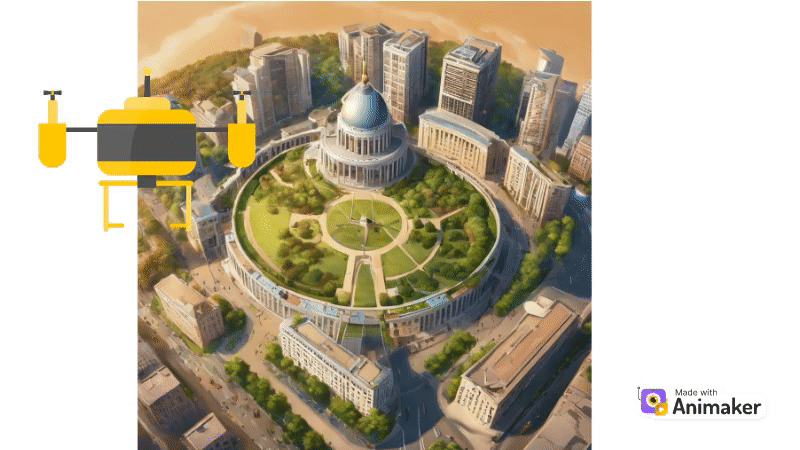
The Prompt: Describe or narrate a scenario about an artwork found a century into a future in which order is deliberately coordinated or imposed. Your description should address issues related to drones and elicit feelings of decadence.
The Narrative: As a particular whirring grew louder amidst the general din from above, he leaned back with a self-satisfied smile.

How marvelous! How decadent! How right! It had been just minutes since he had spoken his desire, and its arrival via the drone network was imminent – the system worked as promised by the facilitators. There was no need to leave home or improperly use energy or pollute the world simply to obtain something he desired. His wish was the drone’s command – as long as it met the facilitators’ vision. After all, this was the 22nd century!

His smile lessened momentarily as he briefly noted that he wasn’t sure who or what the facilitators were, but it returned as the drone settled onto the balcony’s landing pad at his assigned residence.
If he had any interest in history he would know that this was the culmination of drone use. After a period of recreational introduction, drones have been used to change the world. They had rewritten warfare, turning the battlefield into a virtual nightmare with soldiers’ lives quickly snuffed out by distant operators. Then they leveled cities, spread destruction worldwide, and supported the political rise of those who created the most advanced drones. When people couldn’t keep up, drones were removed from their hands and given to AI. That finished the job, and thankfully the drones rebuilt the world they had destroyed, but under the direction of AI and the authority of the facilitators. Everybody was treated the same, cities were built around facilitator structures, and people were placed where they could be comfortable.
But he didn’t know his history, and it didn’t matter, for now, he had what he wanted in his hands, and it was beautiful. He lived in an artwork, a city designed with balance and beauty in mind, and a clear focal point in the form of the facilitators’ building. But his view wasn’t complete until now. This was it – he had wanted a sense of purpose, a vision of his place in this world. And here it was – he could now admire himself in this world. He carefully placed his bust on the edge of the balcony. Sitting back, he gazed upon his perfect self in this perfect world, a smile on his face.

Yet the smile quickly lessened again. There was a vague sense that things still weren’t quite right. There he was, art made perfect, yet something was missing. He didn’t want to see himself alone. His smile returned – never fear, he had simply to ask the facilitators to generate a companion and send its image to his balcony. He began to speak his wish even as the drone network delivered similar images to the balconies all around him.
Sources:
3D Character Generator. (2024) DeepAI. Retrieved July 25, 2024 from https://deepai.org/machine-learning-model/3d-character-generator
Animaker. (2024). Created July 25, 2024. https://app.animaker.com/
Home Alone 2 (2024). Giphy. Retrieved July 25, 2024 from https://giphy.com/gifs/homealone-christmas-home-alone-2-xT0xeK0MXtfbpG9h16
Core77. (2022). Speculative design award: Core77 design awards 2022.
Task 10: Attention Economy
A developing concern, though not particularly new, is the attention economy, and the value of our time and data. Profit is not simply in physical product, but rather in retaining our presence, our time, our ‘clicks’. When our time is spent on one particular application or site, a competing site will view this as a loss of market share. (Harris, 2017) There is competition, strategy, and certainly ethics that connect with this shaping of our experience and our choices.
In that context, trying the assigned User Inyerface game was quite frustrating. The game seemed to use every trick in the book to slow down progress and draw on the time of the user as much as it could.
My initial trial did not result in completion. I’m unclear whether it was because I tried the help box, or input something in the wrong order, but ultimately it did not allow me to proceed beyond the validation pages. This was extremely frustrating as I repeatedly tried to click the correct boxes, yet each time I clicked ‘Next’, it simply returned to another validation page. In the end, I clicked innumerable times without success and invested 15+ minutes without progress.
In the meantime, the site used the following tricks to slow down the process and frustrate the user:
- Popups
- Clickables that default to the wrong thing to click to move forward
- Timers add stress and cause mistakes
- Help bots that are not helpful
- Upload/download – wrong word
- Placeholders that you have to remove rather than them automatically disappearing
- Personal details are out of order
- Flags instead of country names
- Pop-up help bot blocks progress and then withdraws very slowly
- Gender and title mismatched
- Confusing and repetitive human validation
- Validation endlessly (at least for me)
And in the end, I had only achieve this when I gave up:

But I persevered and tried again, carefully avoiding certain pitfalls and ultimately completing the game.

I reflected upon the fact that I continued to try for so long before I gave up on my initial try. Why was I willing to waste my time in that fruitless endeavor? I believe the answer to that is simply that I expected it to be worth it, and that struggling through the process would result in achieving something rewarding. I also hesitated to quit because I was at least partly convinced that the very next try, the very next ‘click’ would complete the process, and if I quit I might be missing out. My attention was held because I valued the possibility of reward greater than I valued my time at that moment.
So frustrating! What made this game so impactful was the fact that I have indeed encountered sites with elements that were being illustrated. I felt anger rising in me, even as I knew there was a point to this game. My attention is the economy, and it has value to those in the business world – I guess the key question is whether it has more value to them, or to me.
References:
Bagaar. (2019). User InyerfaceLinks to an external site. [web game].
Harris, T. (2017). How a handful of tech companies control billions of minds every day [Video]. TED.
Working with data such as the selections made in this assignment can be quite insightful. It can also be one-dimensional if you take the numbers at face value and use them to draw simple conclusions. Considering why selections are made, and examining reasons for the selections allow for greater depth of usefulness and findings. A simple look at numbers does not necessarily allow for proper interpretation as intentions and procedural steps are not considered. These additional factors make the data much more relevant and impactful.
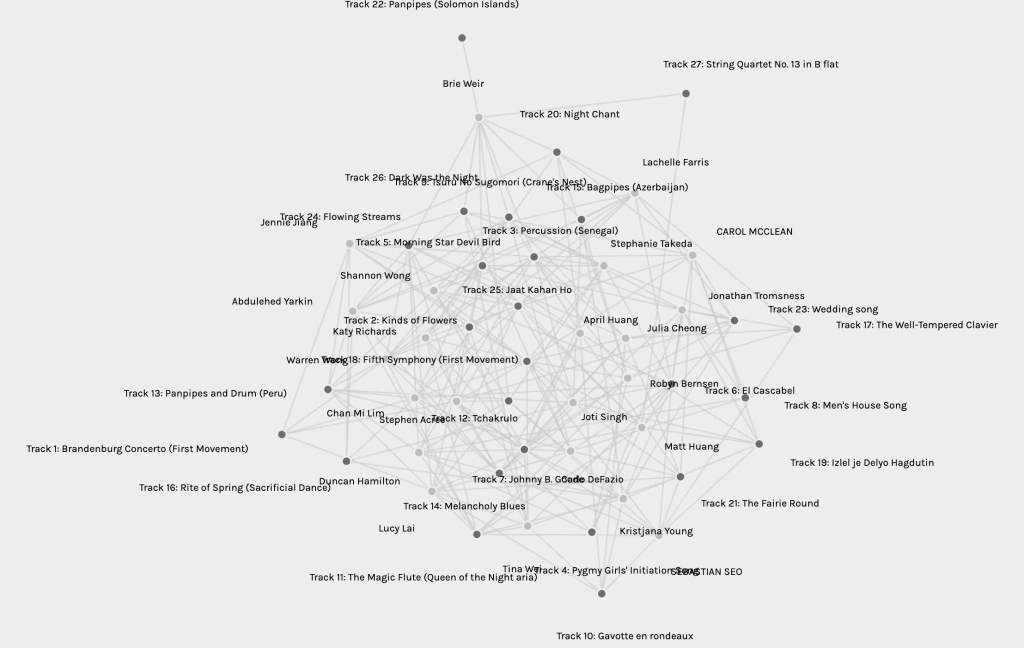
Examining the data in Palladio was quite interesting regardless of limitations. The cloud created with all the data was intriguing, if somewhat overwhelming, and admittedly it took me a while to realize that one could drag around the points for different looks. In the meantime I peered at the graph, noting which of my peers was closest to me, which ones I seemed to share selections with, and which ones were more divergent from my own selections. As I progressed, I began to manipulate the graph for alternative views.

First, I selected the first modularity. This graph limited the data to five individuals who, I presume, shared more characteristics. I could now pick out the individuals, and trace their musical selections, noting commonalities and differences. My own quiz results happened to place me in this group, which made the data more personal and interesting. With a little bit more tinkering, I could make it even more user-friendly.

By moving individuals to one side, and musical pieces to the other, I found myself more able to identify tracks, assess common selections, and take note of unique choices. I took the arrangement one step further.
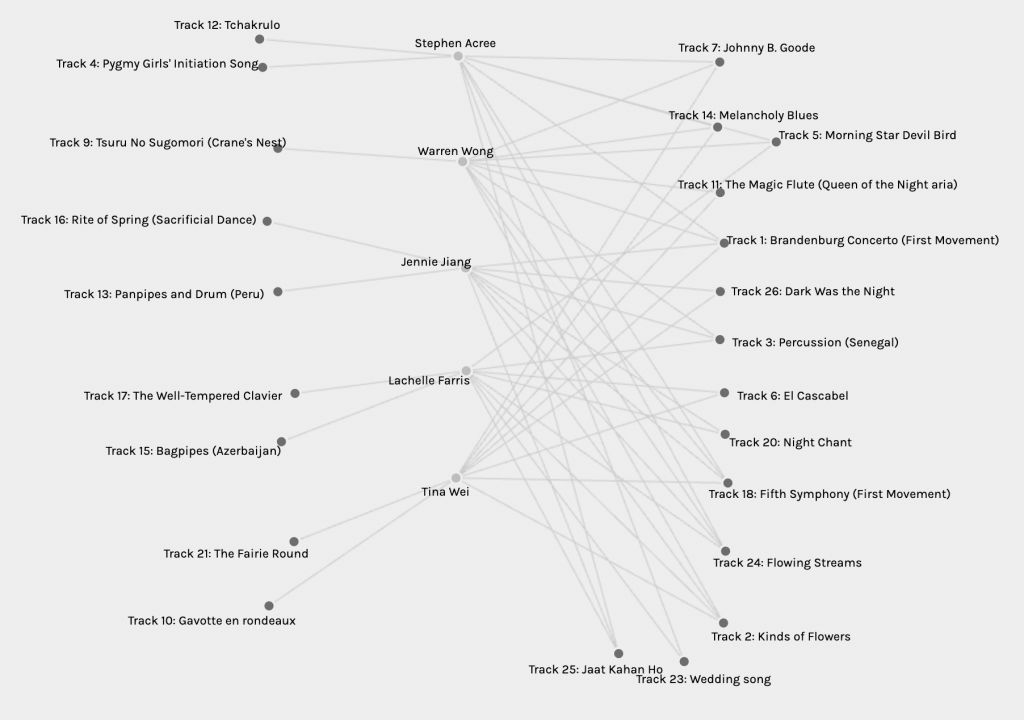
This arrangement was very informative. It allowed for an easy view of common selections and also allowed me to note which musical tracks were unique to individuals in this group. Individuals had 1-2 tracks that they alone selected, while they shared 8-9 tracks with individuals in this group. No track had all 5 individuals select it, which I found very interesting. I also found myself wondering if the unique selections had individuals choose them who were placed in other groups, or data sets. Indeed, when I looked at the data as a whole again, I found that my 2 unique tracks had 4 to 5 of my peers select them, however, they were placed into other groupings.
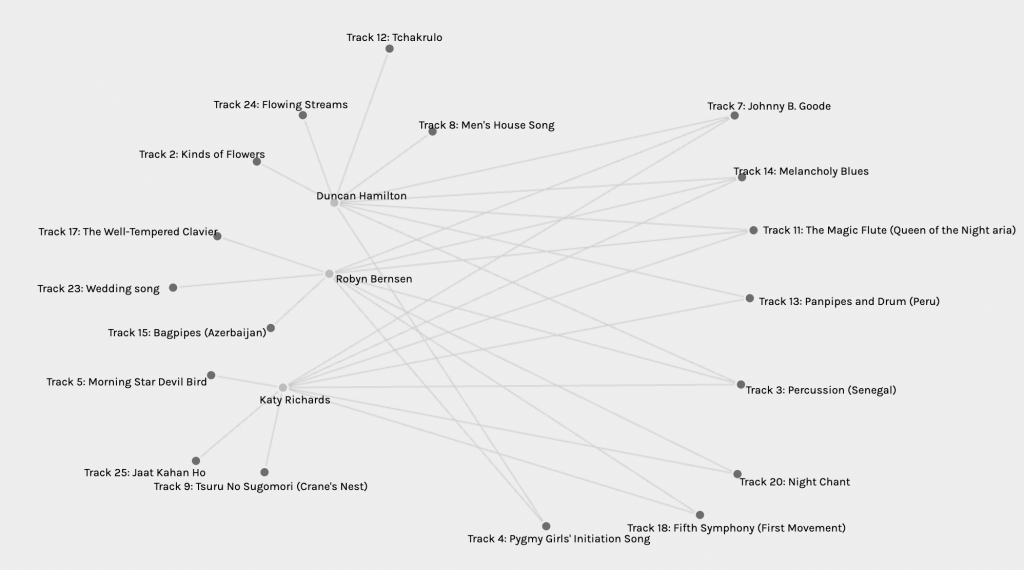
I wanted to consider Palladio graphs with different data, so I selected the fifth grouping. With only three individuals in the grouping, this data visualization is much easier on the eyes, and one can easily identify some differences from the other data group. In this grouping, individuals have 3 unique track selections, and 3 of the tracks have been selected by all of the individuals. I wonder why this is a different characteristic than I observed in the first group?
Conclusions:
It is easy to see the connections between individuals who are placed in the same groupings, or modularities. It would be much more helpful to be able to host an interview and explore both why selections were made, and why we did not select some of the tracks. I believed the Pygmy Girls Initiatl Song to be important, for instance, and that it helped create a widespread representation. So why did the individuals in my group not believe the same? Was it assumed to be unimportant because the Pygmies are not considered leaders in our modern world? This judgment and assumption of bias may not be true at all, yet a data set like this allows for these potential misinterpretations to be made.
While this data is fascinating and produces evidence of trends and differing values, it is simply incomplete without the valuation and insertion of the human element, and the reasons both for and against making certain selections.
References:
Stanford. (2014) Palladio. hdlab. https://hdlab.stanford.edu/palladio-app/#/upload
Task 8: Golden Record Curation
What a fascinating action – curating 27 pieces to send out to any life form that may be out there. This is a first impression, a first contact, and an invitation to judge and to interact. The pieces included in the golden record represent the people of this planet and act as advertisements and encyclopedia entries for this planet.
In curating the list down to 10, I considered the following criteria.
- The selection of songs should be representative of the diverse population of our world, as inclusive as possible.
- The selection of songs should demonstrate the progress and evolution of the art form over time.
- The selection of songs should be stylistically diverse, representing the multi-faceted art form that music is, not just regionally, but also represented in the personal preferences of this planet’s people.
My curated list includes:
- Wedding song – Peru
- Tchakrulo – Choir – Georgia
- Morning Star and Devil Bird- Australia
- Melancholy Blues-L Armstrong&HisHotSeven
- Zaire, Pygmy girls’ initiation song, recorded by Colin Turnbull
- Johnny B Goode – Chuck Berry
- Jaat Kahan Ho – India – Surshr
- Flowing Streams – China
- Bach, Brandenburg no 2, part 1
- Beethoven 5th, part 1, Otto Klemperer
As I completed my list, I sought to include a song from each of the continents and included a variety of musical styles and periods. The Australian piece, for instance, will date from significantly earlier than some of the other pieces. I was prone to include pieces that utilized voices, a piece of humanity that can be heard. Instruments are hugely important, and demonstrate an incredible art form, but actual human voices cannot be replaced by technology.
Task 7: Mode-bending
As I redesigned the task, I tried to think about this in two ways. First, what is a new mode that utilizes technology, stretches my skills a little bit, and provides an engaging way for other to view the assignment? Second, what is a slight adjustment to the task that creates an altered view, even if that view is just from a bit of a different angle?
I selected Animaker and created a short video. There is some time investment, and it took me quite a while to create this minute and half piece to re-examine the image of what was in my bag.
The slightly altered view I selected was that of a geographical journey – an analysis of the setting. In addition to a simple narrative of self, an examination of literacies and temporal periods, I examined most of the objects in light of where the possessor had to journey in order to obtain them. If an investigator were to map the subject’s movements, where would they have to go to retrace the subject’s steps?
Mode-changing is beneficial for this altered perspective. One can take the same image, and the same objects, and add to the overall story by examining them in a different light with a different intention. This is a beneficial practice for many things and many situations in our lives.
I would absolutely have enjoyed doing a longer video and analysis, however in this case the time and effort needed to be limited for me.
Enjoy!
Task 6: An Emoji Story

In taking on this surprising and interesting task, my eyes were opened to the benefits and limitations of emojis as text to convey messages. I did not select the work because it would be easy, I actually selected the last work of cinematography that I enjoyed. On the nights when I need to stay up later than my family to work on meeting a deadline, I sometimes have the TV on to keep me company with something that I know well. The voices help me stay alert, but the familiarity with the plotline makes sure that my attention is not grabbed by the visual.
I started with the title, and I did so because I think it is essential to identify the show and the genre to understand the plotline. I fear it would be nonsensical otherwise. If the title is understood, then the rest of the symbols may fall into place rather than raising eyebrows.
As I related the plot, I relied entirely on big ideas, characters, and actions. I did not utilize syllables at all. The plot has been reduced to quite a basic summary – in fact, I imagine more of a description that would appear on Netflix or a plot overview that may appear on Wikipedia. Certainly, there were a lot more plot details that would be explored using words than is demonstrated by the emojis, and those words would be necessary to communicate the intricacies of character interactions, the subtleties of facial expressions, and so forth. This is what I would describe as the challenges encountered when translating the plot into emojis. The limitations of the provided emojis mean that the artistry, subtlety, the depth of story telling is somewhat lost.
Overall, what I found interesting about this activity is the reminder of the strength that comes with combining words and text. Emojis alone struggle to paint the whole picture, yet words alone in text messages can lead to misunderstandings as they may not convey tone and ultimate purpose. As Bolter wrote in 2000, graphic designers sought to demonstrate that the “combination of word and image offered an experience that was more authentic than the conventional printed page could offer alone.” With today’s integration of text and emojis in messaging between cell phone users, I suggest that they were correct in their pursuit of such a demonstration.
Reference:
Bolter, J. (2000). Writing Space : Computers, Hypertext, and the Remediation of Print: Vol. 2nd ed. Routledge.
Task 4: Manual Scripts
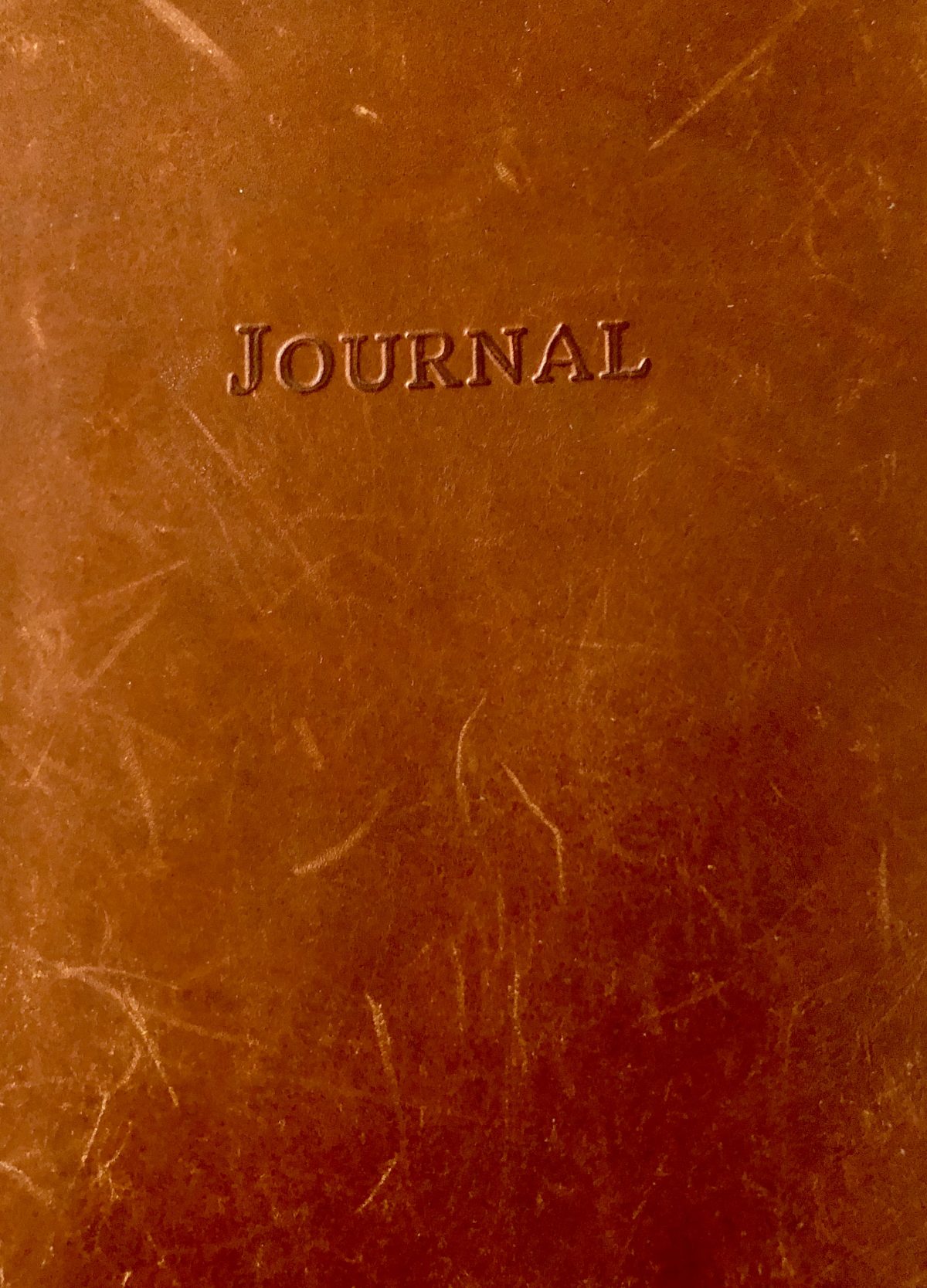
I chose to write a journal entry in response to Task 4, and reflected upon the value of writing by hand, and my own practice.
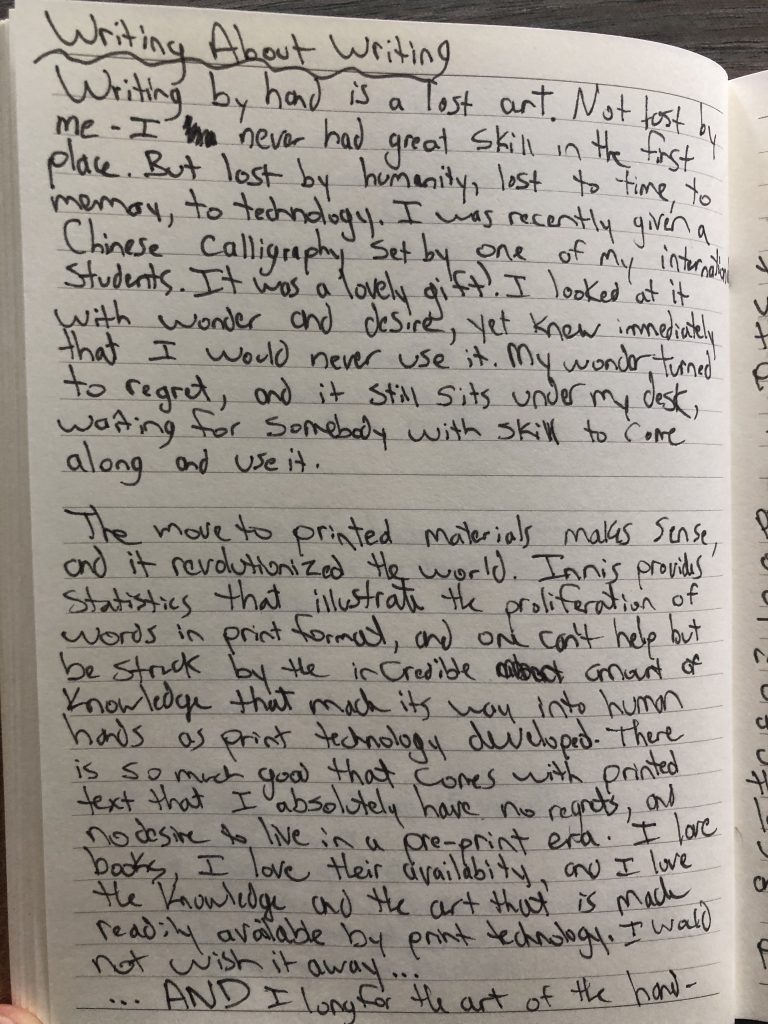
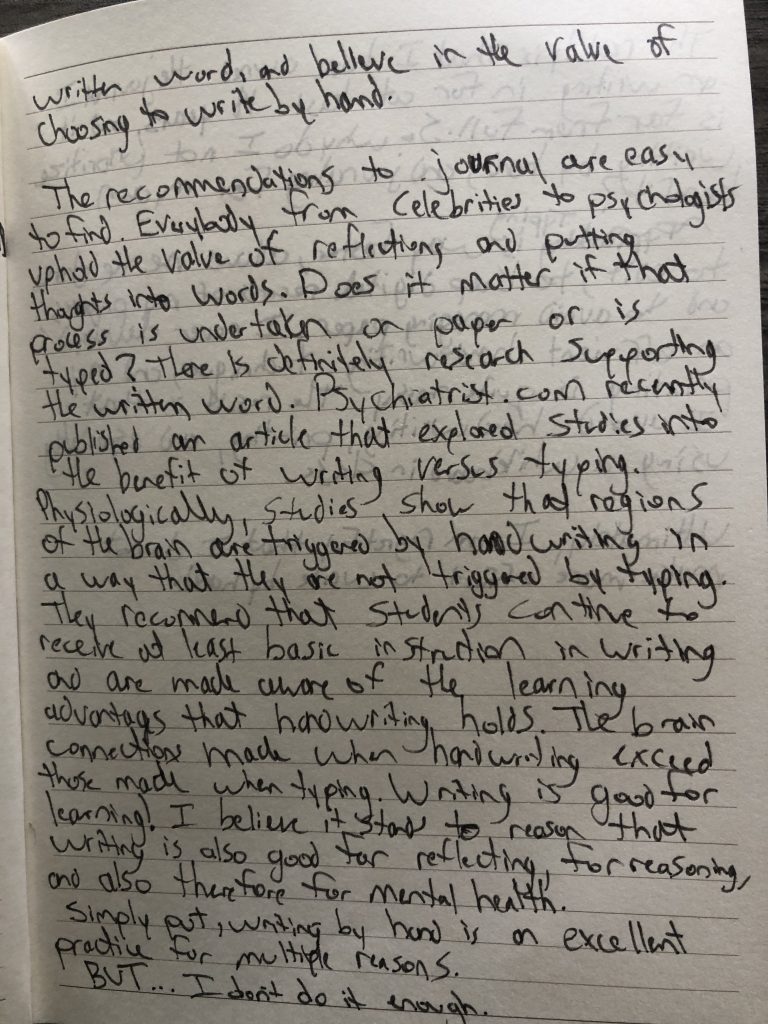
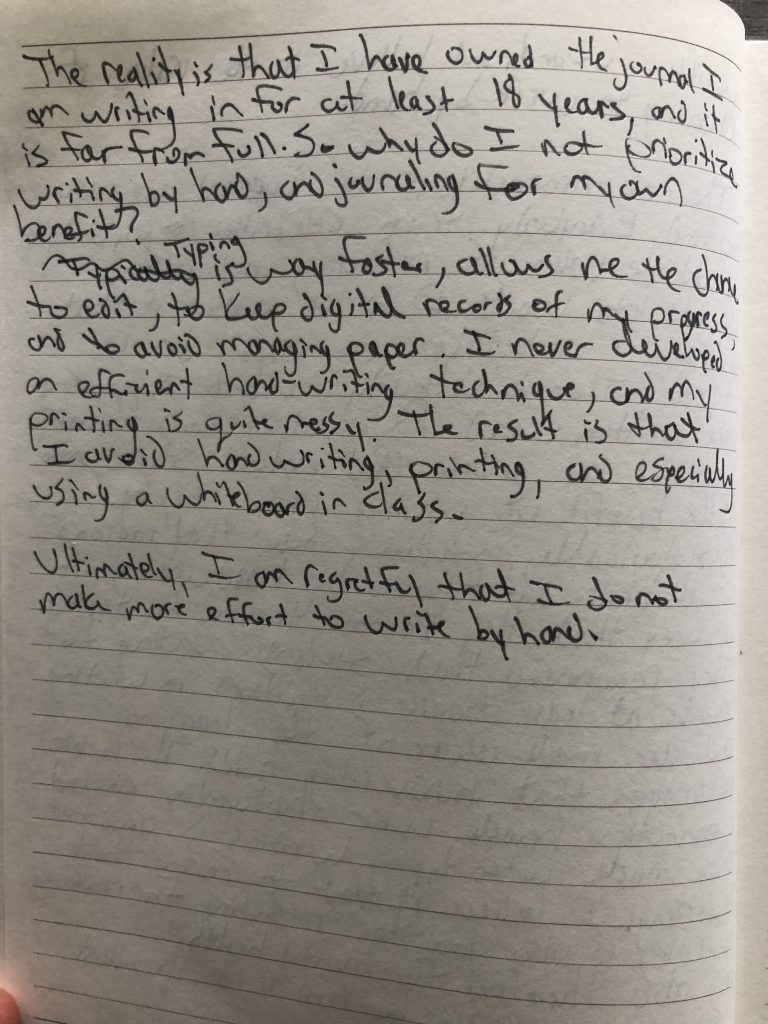
I do not normally write by hand – in fact, I actively avoid doing so in the classroom by using visual technology instead. Writing is challenging for me and has grown ever more so over the years as I have typed more and more. From the time I was a grade school student, writing by hand has been physically challenging and I choose to print rather than use cursive as neatness and style have always been an issue. This holds me back from writing at a pace that I am content with, and a degree of legibility that I might be proud of.
As I wrote this entry, I made a couple of mistakes. Without even thinking about it, I simply scribbled or crossed the mistakes out and continued on with what I intended to write. What I was not able to edit was the overarching message, the arc of the journal entry. If I was typing, I would have gone back and reworked it, ensuring that I was delivering a message that was on target, and that pieced together nicely Instead, I wrote a piece that did not necessarily stick to the point that I intended. Overall I actually think that is okay. The product ended up being a depiction of my thought process instead of a finished product. When I have my students handwrite, I like to see this process, and ultimately I’d rather have what they produce in handwritten form than the edited and refined version that is typically submitted as typed assignments.
In the end, I prefer the individualized, personality-filled written assignments to the more homogenous work created with digital tools. This is the greatest difference and the advantage of writing by hand.
References:
- Innis, H. (2007). Empire and communications. Dundurn Press.
- Storey, D. (2024, January 30). Handwriting Shows Unexpected Benefits Over Typing. Psychiatrist.com. Psychiatrist.com.https://www.psychiatrist.com/news/handwriting-shows-unexpected-benefits-over-typing/
Task 3: Voice to Text Task
For this task I used Speechnotes. I spoke it unscripted as asked, but this is a story that lives in our family lore and I’ve always wanted to write it up as a funny short story. A note of interest to me is that my dictation took over five minutes, but reading it back was notably less time. The act of storytelling was a thoughtful process that led to a slower pace. My analysis follows the transcription.
The Speechnotes Transcription:
So our family likes to go camping. My wife and I have done it right from the beginning of our time together, but when we had kids things changed. I was told there would be no more tent camping, and that a trailer would be necessary. So number of years ago we bought ourselves a little trailer and begin to Camp with our kids. We realize quick quickly that things change a lot when children are involved, and we began to take more stuff along. Once our kids were old enough, this definitely included bicycles
Now bringing bikes is not easy, especially when you have a small trailer and a small vehicle like we do. But I began carefully loading bikes into the trailer, always conscious of how I packed it in such a way that it wouldn’t damage but was inside. It was really awkward, a long time to set up when we got there and to load up before we left.
So I came up with a solution. I went on Amazon, ordered a bumper mounted hitch. I had this vision of the bikes riding along, enough the back of our trailer, which would mean easier loading, your setup, and less potential for damage. It was delivered, yep, again to follow the instructions. If you know anything about me you know that I follow instructions. And these instructions were very specific about tightening the bolts and and balancing the hitch. And so I did so, animals both very specifically to a to the proper weight, done I stood back and I was pretty pleased with myself. I loaded on those bikes, off we went to our favorite camping spot. We love camping outside Nelson BC, goonies are a wonderful place to be, I know it’s a bit of a drive, worth it to us. That week it was beautiful and hot. Never before had we cancel so long, going to stay for 8 Days, which we knew would really stretch the resources of our trailer. But it was a wonderful, waxing time in our family built some great memories. We spent the week playing in the lake, paddle boarding, exploring the area, enjoying the different culture that Nelson offered. We enjoyed our time with friends, laugh a lot, and really did not worry about much. It was about as perfect the time as we could have had as a family.
I’m about the 6th day, daughter came out of the trailer and said something very concerning. She said, daddy, toilet won’t flush! My stomach dropped. With some urgency, I went into the trailer and take a peek. Sure enough, the toilet tank was filled right to the brim. With urgency I told my family no more using the toilet. And we did pretty good for the last couple of days, as we enjoyed our time and got ready to leave.
The day of our departure I drove ever so carefully to the Sandy dump. I did not want anything splashing around, it’s very eager to empty that trailer and get it on the road. It was already hot, my family was waiting for me at the visitor center, and I had to wait in line for a little while. My turn I pulled up to the pump, walked around, and began to pull out the hose. With a clunk, it got stuck and would not come out of the bumper. With a mounting sense of horror, I realized that the tightening of the hitch on the bumper it squeezed it enough that the hose, rather the fitting on the end of the hose, could not slide past that tight Point. What was I going to do? I thought for a minute.
There was a lineup of other families waiting to empty the trailer so they can get on the road, and asking to borrow somebody else’s sanyo’s clearly does not fit within the realm of normal. I thought fast, the sweat coming now. Then I remembered that in the trailer was my son’s hockey stick. We had played with it throughout the week, and maybe it could help. I ran around and pulled it out, before taking it back to the bumper. Using it like a ramrod, like Mom comes troops on the plains of Abraham. I began to batter at the hose in the bumper. I was sweating as if the British troops were bearing down upon me. Once,, three times, many more, and suddenly those shot out of the bumper onto the far side of the trailer. Did you an awful lot of attention.
But it was out. I calmly walked around the trailer, pick those up off the ground, connected everything and took care of business as if nothing unusual had just happened. I may have even smiled and waved at the guy waiting behind me. I managed to do my Sandy dump, and I went to pick up my family. My wife irritably climbed in looked at me and asked why did it take so long? Never mind I said let’s go I’ll tell you later.
Analysis:
As I look over the text, I note that it is much more conversational than conventional written English in several ways. For instance, I began sentences with words like “so” and “now”, a practice that I would certainly comment on in my students’ written assignments. My paragraphs are not structured with a statement, evidence, and explanation as they might be in a more formal piece of writing, rather the paragraphs are divided according to the pauses in my storytelling. Other notable deviations include the lack of quotation marks for verbal sections
What is “right” in the text is the feel of it, the light-hearted effort at entertainment. Overlooking any of the “wrong”, or any mistakes, the text communicates a sense of authorship to tell a good story. With some tinkering, the text could be entertaining enough to evoke a smile.
What stands out as “wrong” is closely tied to the mistakes in the text. This was a story that referenced locations such as the Kootenays, and Speechnotes struggled to recognize those identifiers. It also had difficulties with terms that were camping-specific, such as “Sani-hose” and “Sani-dump”, and simply replaced them with words that do not make sense in context. I found it interesting that Speechnotes made mistakes such as word tenses, missing words, and added words. It made the mistake of simply placing words it believed I said rather than inserting them with adherence to grammar, sentence structure, and basic understanding. I find myself wondering how much it will change as they begin to utilize AI to make these corrections.
If I had scripted the text, I would have read with a more regular pace, avoiding repetition and pauses, and likely speaking with greater clarity. This would have provided Speechnotes with a source that would have been easier to transcribe.
Oral stories are made to be heard with the expression, and the character of the speaker. More than just words, oral storytelling is the complete personalized package of the storyteller. The meaning is not found entirely in the words, and the words may be less powerful or even incorrect in written form. Written storytelling must be well-structured, and “correct” in its conventions to avoid distracting from the narrative and the purpose. While the personality of the storyteller is critical to a meaningful and enjoyable story, written stories place that personality in the minds of the reader. Different readers will have different interpretations, feelings, and responses based on the manner in which they interpret the written words.
This was an enlightening and interesting experience. Based on this, I look forward to experimenting more with dictation technology.